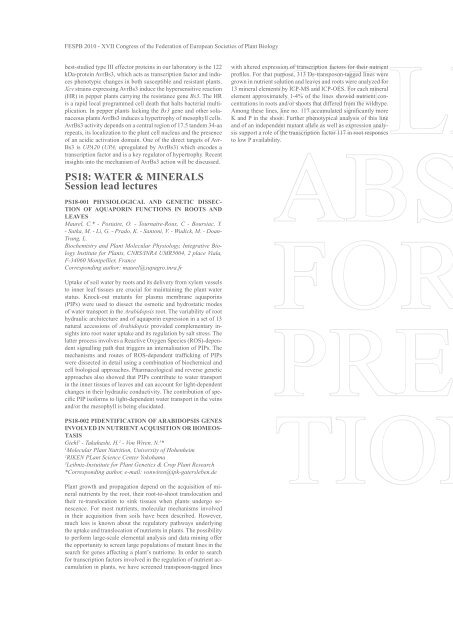Book of Abstracts - Geyseco
Book of Abstracts - Geyseco
Book of Abstracts - Geyseco
Create successful ePaper yourself
Turn your PDF publications into a flip-book with our unique Google optimized e-Paper software.
FESPB 2010 - XVII Congress <strong>of</strong> the Federation <strong>of</strong> European Societies <strong>of</strong> Plant Biology<br />
best-studied type III effector proteins in our laboratory is the 122<br />
kDa-protein AvrBs3, which acts as transcription factor and induces<br />
phenotypic changes in both susceptible and resistant plants.<br />
Xcv strains expressing AvrBs3 induce the hypersensitive reaction<br />
(HR) in pepper plants carrying the resistance gene Bs3. The HR<br />
is a rapid local programmed cell death that halts bacterial multiplication.<br />
In pepper plants lacking the Bs3 gene and other solanaceous<br />
plants AvrBs3 induces a hypertrophy <strong>of</strong> mesophyll cells.<br />
AvrBs3 activity depends on a central region <strong>of</strong> 17.5 tandem 34-aa<br />
repeats, its localization to the plant cell nucleus and the presence<br />
<strong>of</strong> an acidic activation domain. One <strong>of</strong> the direct targets <strong>of</strong> Avr-<br />
Bs3 is UPA20 (UPA, upregulated by AvrBs3) which encodes a<br />
transcription factor and is a key regulator <strong>of</strong> hypertrophy. Recent<br />
insights into the mechanism <strong>of</strong> AvrBs3 action will be discussed.<br />
PS18: WATER & MINERALS<br />
Session lead lectures<br />
PS18-001 PHYSIOLOGICAL AND GENETIC DISSEC-<br />
TION OF AQUAPORIN FUNCTIONS IN ROOTS AND<br />
LEAVES<br />
Maurel, C.* - Postaire, O. - Tournaire-Roux, C - Boursiac, Y.<br />
- Sutka, M. - Li, G. - Prado, K. - Santoni, V. - Wudick, M. - Doan-<br />
Trung, L.<br />
Biochemistry and Plant Molecular Physiology, Integrative Biology<br />
Institute for Plants, CNRS/INRA UMR5004, 2 place Viala,<br />
F-34060 Montpellier, France<br />
Corresponding author: maurel@supagro.inra.fr<br />
Uptake <strong>of</strong> soil water by roots and its delivery from xylem vessels<br />
to inner leaf tissues are crucial for maintaining the plant water<br />
status. Knock-out mutants for plasma membrane aquaporins<br />
(PIPs) were used to dissect the osmotic and hydrostatic modes<br />
<strong>of</strong> water transport in the Arabidopsis root. The variability <strong>of</strong> root<br />
hydraulic architecture and <strong>of</strong> aquaporin expression in a set <strong>of</strong> 13<br />
natural accessions <strong>of</strong> Arabidopsis provided complementary insights<br />
into root water uptake and its regulation by salt stress. The<br />
latter process involves a Reactive Oxygen Species (ROS)-dependent<br />
signalling path that triggers an internalisation <strong>of</strong> PIPs. The<br />
mechanisms and routes <strong>of</strong> ROS-dependent trafficking <strong>of</strong> PIPs<br />
were dissected in detail using a combination <strong>of</strong> biochemical and<br />
cell biological approaches. Pharmacological and reverse genetic<br />
approaches also showed that PIPs contribute to water transport<br />
in the inner tissues <strong>of</strong> leaves and can account for light-dependent<br />
changes in their hydraulic conductivity. The contribution <strong>of</strong> specific<br />
PIP is<strong>of</strong>orms to light-dependent water transport in the veins<br />
and/or the mesophyll is being elucidated.<br />
PS18-002 PIDENTIFICATION OF ARABIDOPSIS GENES<br />
INVOLVED IN NUTRIENT ACQUISITION OR HOMEOS-<br />
TASIS<br />
Giehl 1 - Takahashi, H. 2 - Von Wiren, N. 3 *<br />
1<br />
Molecular Plant Nutrition, University <strong>of</strong> Hohenheim<br />
2<br />
RIKEN PLant Science Center Yokohama<br />
3<br />
Leibniz-Instuitute for Plant Genetics & Crop Plant Research<br />
*Corresponding author, e-mail: vonwiren@ipk-gatersleben.de<br />
Plant growth and propagation depend on the acquisition <strong>of</strong> mineral<br />
nutrients by the root, their root-to-shoot translocation and<br />
their re-translocation to sink tissues when plants undergo senescence.<br />
For most nutrients, molecular mechanisms involved<br />
in their acquisition from soils have been described. However,<br />
much less is known about the regulatory pathways underlying<br />
the uptake and translocation <strong>of</strong> nutrients in plants. The possibility<br />
to perform large-scale elemental analysis and data mining <strong>of</strong>fer<br />
the opportunity to screen large populations <strong>of</strong> mutant lines in the<br />
search for genes affecting a plant’s nutriome. In order to search<br />
for transcription factors involved in the regulation <strong>of</strong> nutrient accumulation<br />
in plants, we have screened transposon-tagged lines<br />
SELE<br />
ABS<br />
FOR<br />
PRE<br />
TION<br />
with altered expression <strong>of</strong> transcription factors for their nutrient<br />
pr<strong>of</strong>iles. For that purpose, 313 Ds-transposon-tagged lines were<br />
grown in nutrient solution and leaves and roots were analyzed for<br />
13 mineral elements by ICP-MS and ICP-OES. For each mineral<br />
element approximately 1-4% <strong>of</strong> the lines showed nutrient concentrations<br />
in roots and/or shoots that differed from the wildtype.<br />
Among these lines, line no. 117 accumulated significantly more<br />
K and P in the shoot. Further phenotypical analysis <strong>of</strong> this line<br />
and <strong>of</strong> an independent mutant allele as well as expression analysis<br />
support a role <strong>of</strong> the transcription factor 117 in root responses<br />
to low P availability.
















